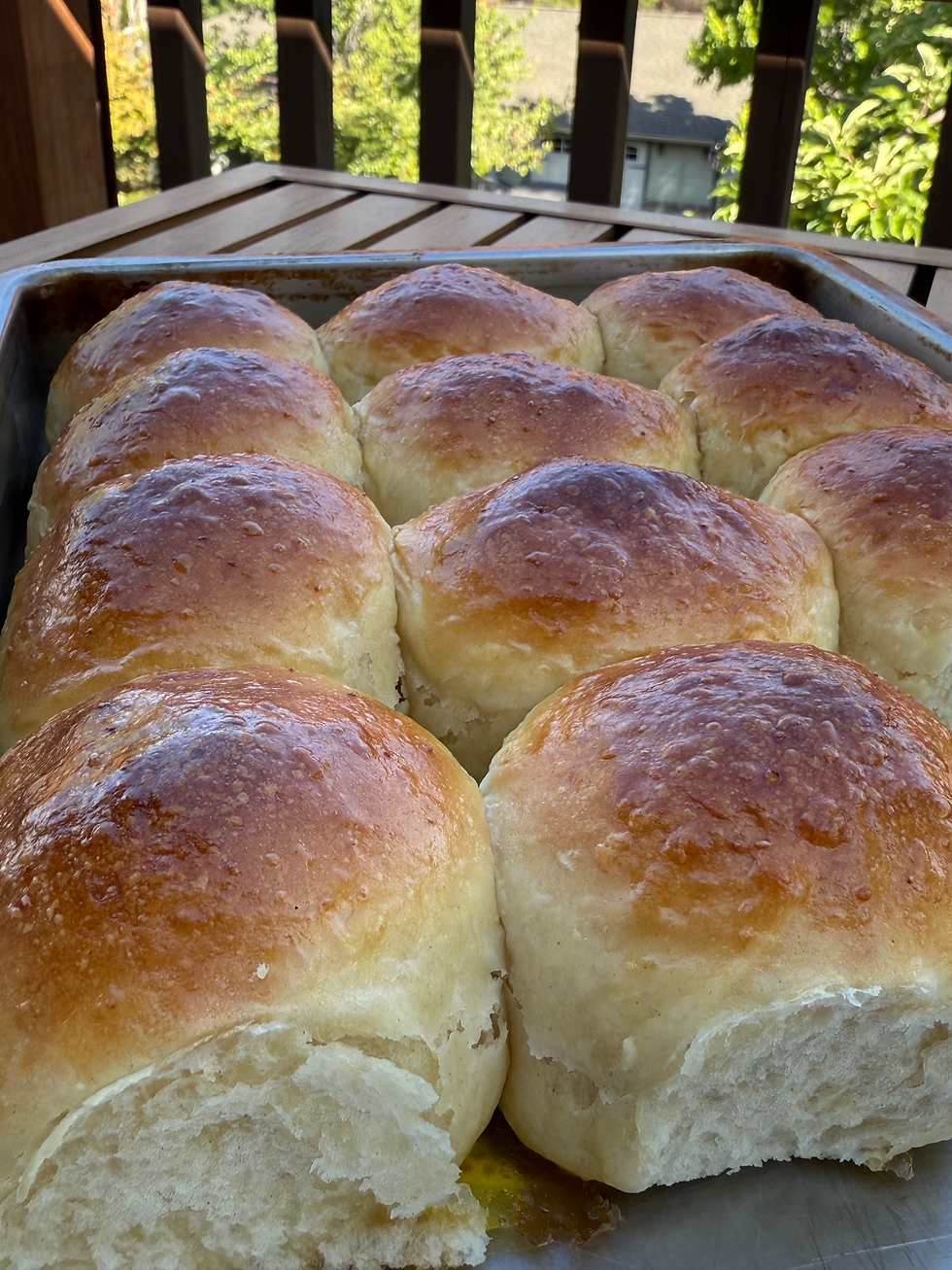Using Eggs in Yeast breads
- Fit Chef Susie

- Aug 17
- 4 min read
Eggs are often suggested for better bread. What do eggs do? How do they function? Best practices when using eggs while making bread? Read on to learn more.

When we discuss eggs in baking; the standard bird we are referring to is the chicken. The colour of the shell doesn’t indicate nutritional values, or flavour. Hens with white feathers and white earlobes produce white eggs. Hens with red feathers and red earlobes produce brown eggs.
Sizes. Small, medium, and large eggs are common sizes sold in North America. Eggs are sold by the dozen-weight. Individual eggs vary greatly. One may be larger or smaller than the next in the same egg carton.
Eggs are considered tougheners due to their ability to provide structure. They however, include both tougheners and tenderizers. The toughener comes from the yolk. The tenderizers come from the white.
What does adding an egg to bread do?
Eggs contribute structure to a loaf. It makes the bread lighter, fluffier, and increases the volume of the loaf. It also adds flavor. Adding eggs contributes color and browning. Eggs also help prevent retrogradation - stale baked goods.
The fat in the yolk—-that inhibits gluten formation just as any other fat would. This results in a looser dough that can expand more. Yolk is high in lecithin, approximately 10%. The main function of lecithin is the bonding of water and oil; producing a nice crumb.
The egg white—acts as a coagulant and sets the crumb making it bouncier and chewier in a good way.
The crust is another part of the bread that is greatly affected by egg. It caramelizes more and becomes crispier. Breads that contain lots of egg should not be baked at very high temperatures, as the crust may go too dark too quickly.
Interestingly, eggs interfere with raw dough’s gluten formation, yet they provide structure to the loaf once baked. That is why some high-egg breads like brioche are prepared with the recipe asking for eggs to be added at the end of the mixing. Thereby, allowing gluten to form before adding the eggs.
The recipe calls for room temperature eggs? Should you place your eggs on the counter and wait?
In a word, no, placing eggs that have been previously refrigerated, on the counter and bringing to room temperature is not food safe and should be avoided to prevent food borne illness. (If you buy eggs at room temperature follow your local egg producers storing rules.)
Instead, place your shelled egg in a cup of warm water for 5-10 minutes to remove the chill.
Do you need to blend eggs before adding to pan? It’s not necessary. The machine will blend them in.
Egg wash?
Egg wash can be used on prepared dough. Mix 1 large egg with 1 tbsp water or milk
If your egg wash doesn’t apply evenly add some salt to your egg wash. (Let sit in fridge for a couple hours to denature the proteins.) Use as usual.
Using a yolk-only wash produces a resultant bread with more browning and sheen.
Egg washes can be the ‘glue’ for bread that has nuts or seeds sprinkled atop.
Soy milk is often recommended as a plant-based “egg wash”. It gives a comparable color to a traditional egg wash. Oat milk works albeit with a lighter color as well
What if you divide a recipe and it means the recipe would call for half of an egg? What do you do?
A whole large egg weighs approximately 50 grams and is roughly 75% water so that extra half egg will contribute just under 20 grams of additional liquid to your recipe - you will need to compensate for that additional liquid either by reducing your water contribution accordingly or by adding a little extra flour (like 30-ish grams).
This means you are only adding an additional 5 grams of protein and fat from the egg by including that extra half. You will probably notice a slightly more tender or soft texture in your finished loaf from the slight increase in egg.
What if you seldom keep eggs in your house?
Freezing eggs is a viable option. Remove the egg from the shell. And blend the white and egg yolk thoroughly. Sprinkle a pinch of salt and freeze. Thaw in the fridge and use as per the recipe .
Baking egg-free?
Eggs provide structure, emulsify, bind and help leavening. Flaxseed can be used. Ex. 3 eggs would be 6 tbsp flaxseed (very finely ground) and 1/2 cup + 1 tbsp water. Let sit 10 minutes. A simple search can help you find other quantities.
Neat trick: bread made with only egg YOLK. The egg yolk crust produces the crispiest crust. The loaf was larger and it had the airiest, and creamiest crumb with a slight eggy flavour which was stronger than a bread made with a traditional whole egg.
This data came from KAF, culinary textbooks, and legitimate sources.
Please keep it kind. T.H.I.N.K. Is it Thoughtful? Is it Helpful? Is it Inspiring? Is it Necessary? Is it Kind?
Happy baking
Susy








Comments